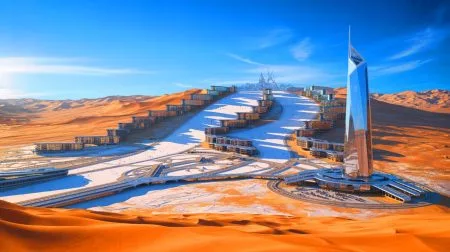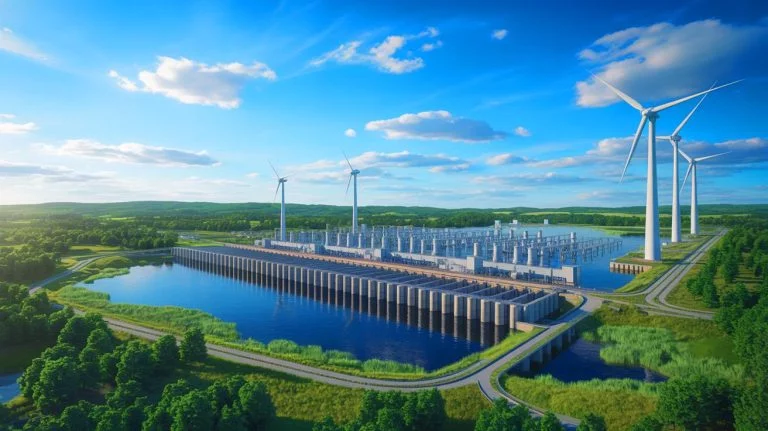| IN A NUTSHELL |
|
Imagine a world where our serene lakes transform into bustling powerhouses of energy. This concept, once a figment of futuristic imagination, is now a burgeoning reality. The idea of turning lakes into colossal power plants is not just about tapping into a new energy source; it’s about reshaping how we think of natural landscapes and energy production. With batteries being pivotal in our daily lives, from cell phones to electric cars, the potential to revolutionize their power sources stirs both excitement and curiosity. This article delves into the innovative approach of converting lakes into energy generators and its implications for the future.
Lakes as Colossal Power Plants
For over a century, hydropower has been synonymous with massive dams—engineering marvels that, while providing renewable energy, often disrupt local ecosystems and communities. Recent studies by the Global Energy Monitor highlight an evolution in hydropower projects that promises to mitigate these issues. Enter the concept of ‘pumped storage,’ an innovative system that utilizes two reservoirs at varying elevations. Excess electricity, often produced by nearby power plants, is used to pump water from a lower to an upper reservoir, effectively storing energy.
When energy demand peaks, this stored water is released back downhill through turbines, generating power without the need for traditional dams. This method mirrors battery function, offering a sustainable and less intrusive solution. By using the natural gravitational pull of water, these projects aim to redefine not only how we harness hydropower but also how we integrate it into our landscapes.
The Renaissance of Pumped Storage
Although not a novel idea, pumped storage is gaining renewed interest, particularly in regions experiencing rapid wind and solar energy expansion. This approach addresses concerns about climate-related fluctuations in renewable energy production. Some of the largest pumped storage systems can generate enough electricity to power two million homes for an hour.
China, a leader in renewable energy growth, has significantly contributed to this resurgence. Its commitment to increasing wind and solar power capacity, despite continuing coal use, underscores a broader strategy to diversify energy sources. While China has ceased funding coal projects abroad, it continues to approve new coal plants domestically. However, these efforts are part of a larger plan to reduce overall energy output by integrating more sustainable options like pumped storage.
Hydroelectric Surprises in the Making
Global Energy Monitor data reveals another hydropower technology gaining traction, particularly in mountainous regions like Nepal. Run-of-river hydropower plants, unlike traditional dams, do not create large reservoirs. Instead, they rely on natural river flows to generate electricity, resulting in a less invasive environmental footprint.
Without the need for massive reservoirs, these plants are less likely to cause significant ecological damage. They offer a reliable energy source that adapts to seasonal water availability, making them particularly suitable for tectonically active areas. This innovative approach to hydropower, combined with the concept of lake-based batteries, presents a future where energy production and environmental conservation coexist harmoniously.
Potential Projects in the United States
In the United States, exciting projects are emerging, particularly those exploring the potential of the Great Lakes for hydroelectric power. These initiatives propose building reservoirs at lower altitudes to harness the energy from waterfall flows. Initially gaining traction in 2020, these projects faced delays due to the pandemic but are now poised for a comeback.
The idea of transforming the Great Lakes into power plants encapsulates the essence of innovation in energy production. By utilizing existing natural resources, these projects aim to deliver substantial energy outputs while minimizing environmental disruption. Such ambitious endeavors not only promise to enhance the nation’s energy landscape but also inspire a global movement towards sustainable power solutions.
As we stand on the brink of an energy revolution, the concept of converting lakes into colossal power plants invites us to rethink our relationship with nature. This innovative approach, blending technology with natural resources, holds the promise of a sustainable future. Will these initiatives redefine our energy landscape and propel us towards a greener tomorrow?
Did you like it? 4.6/5 (28)







Wow, turning lakes into power plants sounds like something out of a sci-fi movie! 🚀
How will this impact local wildlife and ecosystems? 🦆
Is this technology already being used anywhere else in the world?
I’m curious about the cost. Will this really be free for consumers?
Finally, a solution that doesn’t involve giant dams! 🙌
Sounds great, but what happens during a drought?
Why hasn’t this been done before if it’s so beneficial?
Thank you for shedding light on this innovative approach to energy! 🌟
Are there any risks of water contamination with this method?
How long until we see these projects completed in the U.S.?
Love the idea, but I hope it’s not just another way to exploit nature.
This sounds too good to be true. What’s the catch? 🤔
With all these advancements, future generations will have a cleaner planet. 👏
Are there specific lakes chosen for these projects, or is it still under study?
Is there a possibility of flooding with this pumped storage technology?
Great article! It gives me hope for sustainable energy solutions. 🌍
I wonder how this compares to solar or wind energy in efficiency.
How do they ensure the local communities benefit from this energy?
Seems like a lot of infrastructure would be needed. Who’s funding this?
Can we expect to see lower energy bills soon? 💸
Cool idea, but wouldn’t it be better to just use wind and solar? 🤷♂️
Is this the end of traditional hydropower as we know it?
The Great Lakes as power plants? That’s a bold move!
How about the environmental impact, any studies on that?
Why is China leading the way here and not the US? 🧐
How much energy can a single lake produce on average?
Will this technology be able to adapt to climate change effects?
Are there any downsides to using ‘run-of-river’ plants?
What about the maintenance costs of these projects?
This could be a game-changer for renewable energy. Keep it up! 🚀
Can this technology be applied to smaller bodies of water too?
Will there be any job opportunities for local residents?
It’s amazing how innovation can turn natural resources into powerful allies!
Why isn’t this more widely known? Everyone should be talking about it!
Fingers crossed this doesn’t become another failed project. 🤞
Is there any opposition from environmental groups regarding these projects?